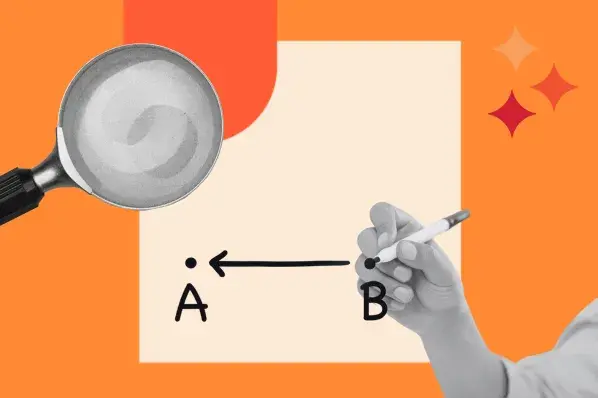In this post, I’ll talk about how you can perform a content audit for your own business and go over high-quality tools to help you streamline the process.
I’ve also sourced helpful tips from SEO and content professionals, which I’ve included throughout the article.
Keep reading, or use one of the links below to jump ahead to the section you're looking for.
Table of Contents
What is a content audit?
A content audit describes the process of collecting and analyzing assets on a website, such as landing pages or blog posts. Content audits keep an inventory of a website and provide insight into which content to create, update, re-write, or delete.
Content Audit Goals
Running a content audit for your website can boost your traffic and improve the experience of your readers.
First, content audits help you take note of the areas on your website that aren‘t properly optimized for search engine rank. For example, you might add meta descriptions to your blog posts as part of your current strategy. If that always wasn’t the case, a content audit helps you locate which posts need to be updated.
Content audits also help you find new SEO opportunities for your website. For example, did you know that adding keywords to the headings on your site gives search engines more clues about what your web page is about?
If search engines have as much knowledge as possible about the content on your website, they'll be able to suggest your web pages to browsers more accurately.
Running an audit is a chance for you to update the content on your website to improve readers' comprehension of your site. For example, you might not know the links on one of your product pages are broken, but a content audit provides you with a reminder to update those links.
I’ll discuss some additional benefits below.
Benefits of Content Audits
Your content audit should help you bring your content up-to-date, improve the rank of your web pages, and make the website you present to readers easy to navigate and free of error. In addition, in my experience, content audits:
- Give data-driven insight into the performance of your content, helping you make informed decisions based on factual information rather than just assumptions.
- Identify areas for content repurposing or updating where numbers are lower than desired.
- Highlight pieces of content that perform best that you can leverage in marketing materials.
- Understand more about what your audience likes and dislikes.
- Content maintenance becomes easier when you have an understanding of what you’re offering.
To make sure your website content audit is valuable, carve out enough time to complete it. I’ve put down a step-by-step guide to help you through the process.
How to Run a Content Audit
Each audit should be tailored to the needs of the organization, and I feel that the steps below can help you create a custom process to reach your content goals.
1. Think of your goals.
First, I’d think about what you want to accomplish. When you have your goals in mind, you will have a better idea of how to categorize your audit later.
For example, if my goal is to increase brand awareness, I might audit the content with the goal of increasing branded keywords.
Other goals to consider could be figuring out which pages need to be SEO-optimized or finding the best-performing website content to place on your homepage or in your email newsletters.
Ultimately, a content audit identifies engaging content for your audience. It can also include information on SEO and conversion rates. This process will help you see the strengths and weaknesses of your content and workflow.
Leading with company goals will ensure your content audit is useful for tracking and updating your strategy with improved tactics. After this is complete, then it's time to collect your content.
2. Gather your content and create an inventory.
Which content are you going to audit? Content audits might include:
- Blog posts.
- Landing pages.
- Product descriptions.
- Video media.
- Online publications.
Decide which content you want to audit and gather the backlog of that content. Pulling your content together in an organized spreadsheet will create a content inventory. This will make it easier to track changes and goals for your content.
To start, I’d collect URLs and other page information for the web pages I've chosen to audit. Page details I might want to collect to begin the audit include:
- Page title.
- Content type.
- Content format.
- Word count.
- Date last modified.
- Linked CTAs.
A content audit template can help you quickly pull together a content inventory to begin your audit. There are also online tools to help you collect this data, like SEMrush, Screaming Frog, and HubSpot.
Pro tip: Some tools will provide this information based on your sitemap. A site map is a file that has all your website's information. You can usually create your sitemap for free online. For more information, check out this sitemaps guide.
3. Categorize your content.
After I gather the content, I’d categorize it on a spreadsheet. Tracking every metric for every piece of content can get overwhelming quickly. So, use your goals to guide the categories you track for your audit.
Think of categories that offer useful insights from different pieces of content. For example, an SEO audit focuses on metrics like keywords, page speed, and backlinks. But if I’m running a content conversion audit, I may want to focus on traffic, click rate, and different types of conversions.
Some online tools will include metrics in audit data as well. Tools like Google Analytics can help pull this data. Metrics can add value and context to your analysis.
Some online tools can categorize the information for you, but it’s often helpful to do it yourself. Adding relevant categories will keep you organized, so your content audit meets your needs.
In my opinion, it can be tempting to add and remove categories throughout the process, but this can give you more data than you‘re able to analyze. It’s also easy to start analyzing data before you've finished categorizing.
But these habits can also make the process more complex and time-consuming. They can also lead to hasty and incorrect analysis. If you notice interesting or surprising data, take a quick note, but keep categorizing before you start your analysis.
In this step, your goal is to complete a spreadsheet with the categories of data that you need to audit your content toward a specific goal.
Pro tip: Angèle Chevalier, SEO and content strategist at CharlieHR, shares a recommendation to help prevent spreadsheet overwhelm. (Quick note: this step combines both categorizing and analysis of data).
“I use visualization tools like Miro to make content audits much easier, especially when it comes to identifying content gaps,” Chevalier says.
Chevalier first organizes each piece of content in a spreadsheet, ensuring it’s attributed to the right funnel stage, topic cluster, and website location. All the metrics stay on the sheet.
From there, she pulls out each page with its criteria and maps it visually. Once the pages are grouped by topic, it’s much easier to spot gaps and identify which parts of the funnel need filling.
“While this might sound time-consuming, it’s far more effective and creative than staring at spreadsheets all day. Plus, you can tackle it in batches to keep it manageable and avoid the repetitive side of it,” Chevalier says.
4. Analyze your data.
Now, it's time to look at your data critically. This is the step that will give you a good measure of the state of your content. When analyzing your data, here are some things to take note of:
- Content that‘s missing — What is your audience interested in that you haven’t covered?
- Content that‘s underperforming — Which pieces of content aren’t getting the numbers you want?
- Outdated content — If you have old content, can you update or rework it for optimization?
- Top content — Content that has performed extremely well.
- Word count — Is there a sweet spot for word count?
Based on the results of this analysis, organize them in the spreadsheet. A way to do this is to assign different colors based on what you're analyzing. Then, highlight the rows with those colors so you have an idea of which category is which. This can help you see which content takes up the largest part of your content library.
It‘s also a good idea to scan your results for patterns, trends, and connections that can be hard to see when you’re looking at standard reports. For example:
- Are there outlier posts whose performance exceeds expectations?
- Are there new topics that are getting more attention than they did a few months ago?
- Have organic backlinks spiked for specific content?
This information can help you recognize some of the happy accidents that are impacting your content performance. You can use this data to expand these ideas into your content strategy and tactics.
Pro tip: Georgia Tan, co-founder and head of search at Switch Key Digital, recommends another aspect to keep in mind. “Analyze user behavior to gain valuable insights into how users interact with your content and identify areas where your content falls short,” Tan says.
According to Tan, tools like heatmaps and user session recordings can reveal areas where users drop off, spend little time, or show signs of confusion.
You can then use this data to identify content that users consistently ignore or abandon, content which users have low engagement with, or that shows potential to attract their attention for longer.
“Use user behavior data to refine your content strategy by identifying opportunities to improve content structure, visual appeal, and the relevance of the information presented,” Tan says.
If you’re diving deeper into your content audit, here’s a step-by-step guide to mastering the content audit process that includes tips on prioritization and evaluating performance metrics.
5. Create action items.
In this step, you will finalize and clean up your audit. You now know what to focus on based on the analysis and can go from there. Think about the posts to delete, update, re-write, or re-structure.
To organize these action items, I’d add one last column to the spreadsheet — one that's close to the front so you can keep tabs on it. This column will let you know the action to take on a specific URL. For example, are you going to keep, update, delete, or re-write that blog post?
If you plan on ranking by priority or including a timeline for this audit, now would be the time to include that. Some organizations use editorial calendars, while others choose a more casual approach.
To make a priority timeline that fits best with your content audit, think back to your initial goals and rank the items you want to execute first.
Keep this list of action items top of mind. As a result, your next content audit will show clear progress toward your goals, based on the data you found during your audit.
Content Audit Template
You don‘t have to go through an SEO or content audit process without a compass — there are plenty of templates to guide you if you’re unsure of where to start.
To show you how a template can speed up the process, check out HubSpot’s kit on How to Run an SEO Audit. It’s a nine-step guide that acts as a template, walking you through the process of an SEO audit — with dedicated sections on content and on-page SEO. Best part? It’s completely free.
Using sections from the above kit as reference, I’ve put together a content audit template that’ll make it simple to understand what details to look for and fill in. Feel free to add or delete sections as per your or organizational needs.
To start, open a spreadsheet tool and follow along.
Page Type

In the first column, I’ll specify the page type for each page I’m auditing. It works for many page types, like a home page, landing page, blog post, or even a form page.
URL
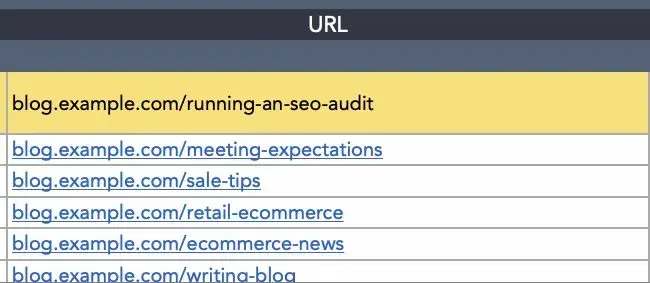
Then, I’ll fill in the URL.
Canonical Tags
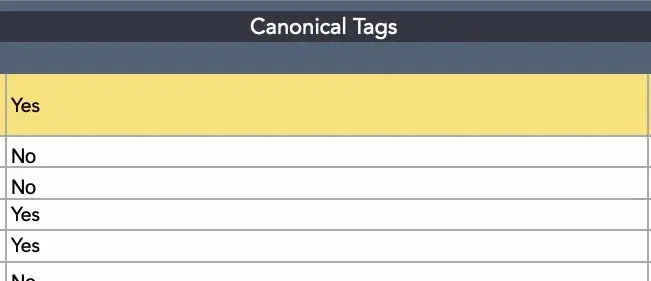
Next, I’d note any canonical tags the site may have. Remember, you can find canonical tags in your page's source code.
Pagination
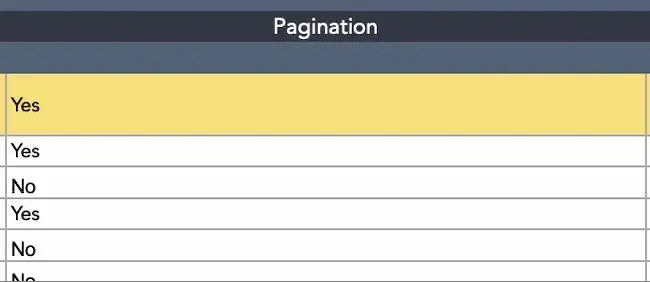
After that, I'd note if the page is a part of a sequence of pages to ensure that the code is properly formatted for sequencing.
Page Title
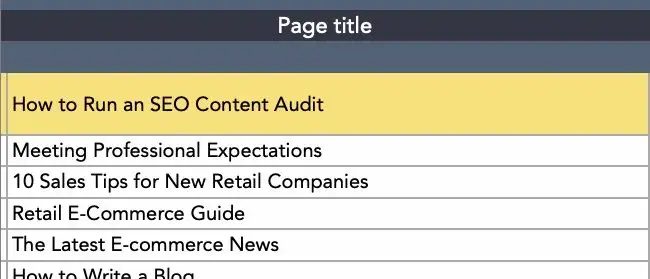
Next up, I‘ll fill in some details about the page’s copy. For instance, the page title. If I included a blog post similar to this one in the audit, for example, I would put “How to Run an SEO Content Audit” in this section.
This section helps me later check that I have the primary keyword in the page title, boosting SERP rank.
Page Purpose
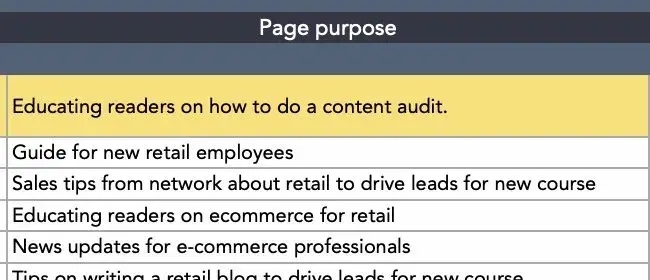
In this section, I'll define the goal of each page.
So, for this blog post, I would define the purpose of this post in a short and descriptive sentence. For example, “Educating readers about how to do a content audit.”
Focus Keywords
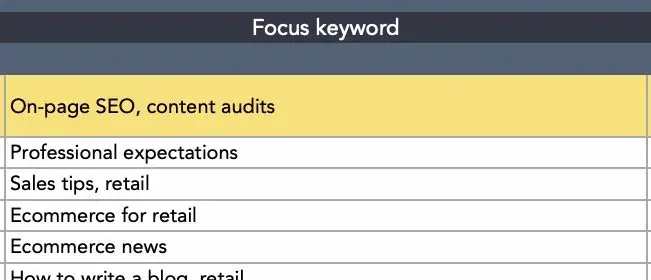
Then, I'd note the focus keywords of that page. My keywords for this post would be something akin to “On-Page SEO” and “Content Audits.”
Headlines
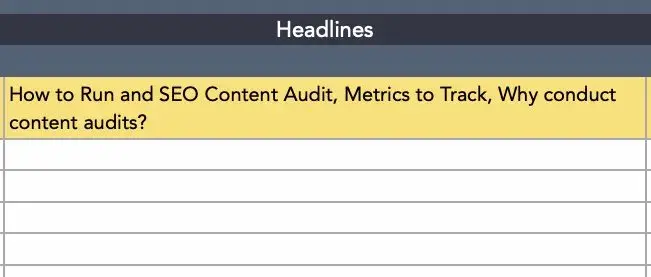
After that, I’d note the headlines or title tags on your page. A good rule of thumb is to make sure at least one keyword appears in an H2 to help rank.
Meta Descriptions
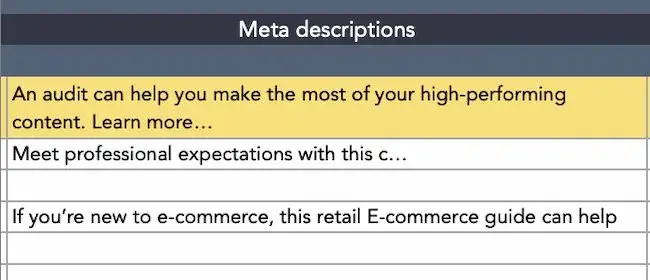
Here, I’d note whether the page has a meta description and what it is.
Pro tip: Here’s a guide to writing meta descriptions.
Images

Once I outline the headings and meta description, then I'll focus on images. I’ll include the file name of the images and note the alt text.
Pro tip: Alt text tells Google what your image is about, so if your images don't have any, this is a good reminder to add them.
Internal and Outbound Links
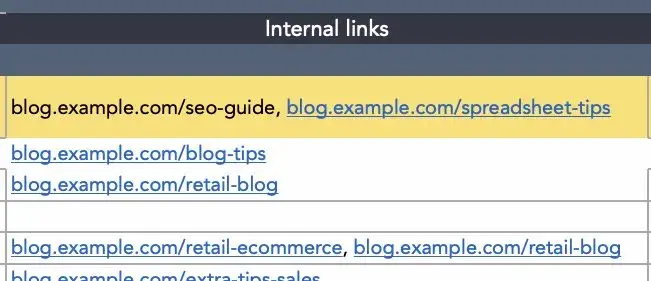
Next, I’m going to focus on links: internal, outbound/external. I’d include the link URL and anchor text in the spreadsheet. Note: the above image doesn’t show anchor text, but you can add it in brackets near the link.
Pro tip: During the optimization process later, remove broken internal links, and make sure your page has at least three relevant ones. Remember, internal links help you to boost the traffic of other pages on your site.
Page Speed
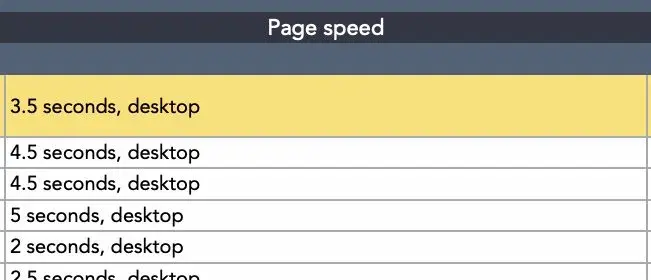
Following link optimization, I’d note the page speed. If the page takes longer than two seconds to load, it might not keep the reader's attention.
Social Sharing
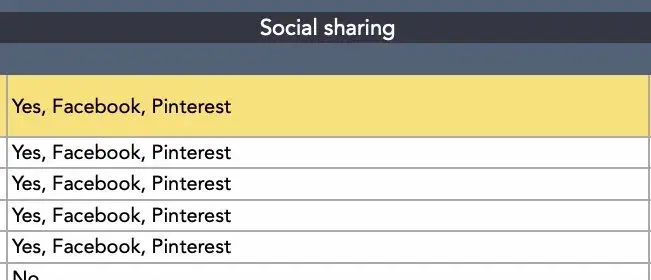
Next, I’d note down whether the page is available for sharing on social media.
Content

I’d also review the contents of the page, paying special attention to the length of your copy and where and how keywords are used. This is also a chance to check for duplicate or similar content.
Mobile-friendly

Finally, I’d check the page on mobile devices to help improve the accessibility of the webpage.
Once you’ve entered these details in your template, you’ll begin to get a clear picture of what you can do to optimize your page. As you add more pages to the template, you may start to notice issues that come up repeatedly or holes in your content strategy.
For example, the “Images” section may show that several posts are missing images and alt text. For those that have alt text, the copy might not be optimized for some focus keywords.
This content audit data can help you form a data-driven foundation for strategy updates and recommendations.
Content Audit Checklist
A content audit checklist helps ensure you’ve ticked off the right steps as you perform a content audit. I wouldn’t want to be midway through an audit, realize I missed a crucial step, and then have to backtrack. A checklist helps prevent that.
Here’s a quick and simple content audit checklist you can use to make sure you’re on the right track.
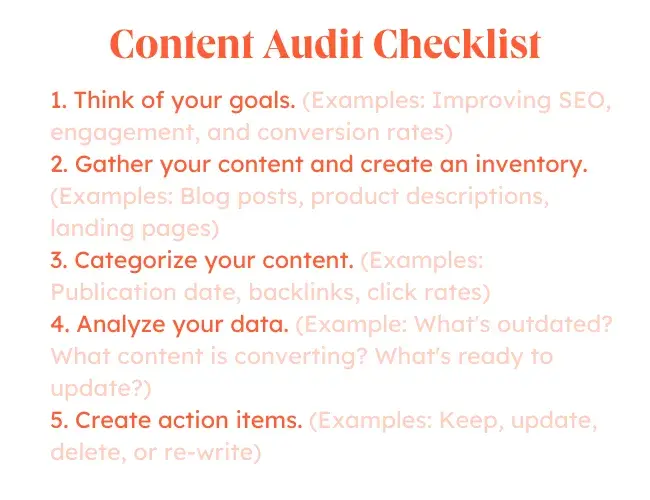
Pro tip: Lisa Kubatzki, Senior SEO Content Manager for the DACH market at GetResponse, advises: “Don’t give up on content pieces with low SEO value so quickly. That means content pieces with low to zero organic traffic or low rankings,” Kubatzki says.
Instead of simply deleting them, think about how to repurpose them.
“Is this content really good quality-wise? Re-use it for a PR campaign or try to give it a social media push. Could it be improved? Update the information, try a new format or re-write it, looking at the topic from a new angle,” Kubatzki emphasizes.
Now, I’ll go over some content audit tools you can use to further automate your content audit process.
Content Audit Tools
- Screaming Frog
- Ahrefs
- SEMrush
- Google Search Console
- Google Analytics
- WooRank
- Google Sheets
While not a requirement, choosing a content auditing tool can help you with your process. Rather than gathering URLs manually, the tool can automatically aggregate the content you’re looking for and display metrics for you to see.
But, I feel that the most significant value of content audit tools is that they are fast, helping you save a considerable amount of time.
SEO Tools
1. Screaming Frog
Price: First 500 links free, unlimited for $259/year.
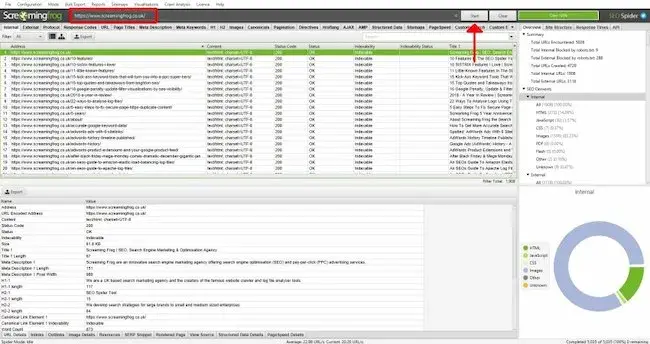
Screaming Frog is a website crawler. It collects URLs from your sitemap and creates an SEO audit list for you. If you have a smaller site, Screaming Frog can audit up to 500 URLs for free.
The desktop Screaming Frog website is great because it provides a ton of analysis about your website and categorizes it for you.
Pro tip: Emina Demiri-Watson, head of digital marketing at Vixen Digital, talks about a visualization tool on the platform.
“Screaming Frog’s Force-Directed Crawl Diagrams coupled with Google Search Console API data is a brilliant visual way to support your content audits. By scaling nodes based on clicks, you can easily spot high-performing pages (according to clicks) and identify those that need attention,” Demiri-Watson says.
2. Ahrefs
Price: Pricing for this tool starts at $129/month and they offer Lite, Standard, Advanced, and Enterprise plans.
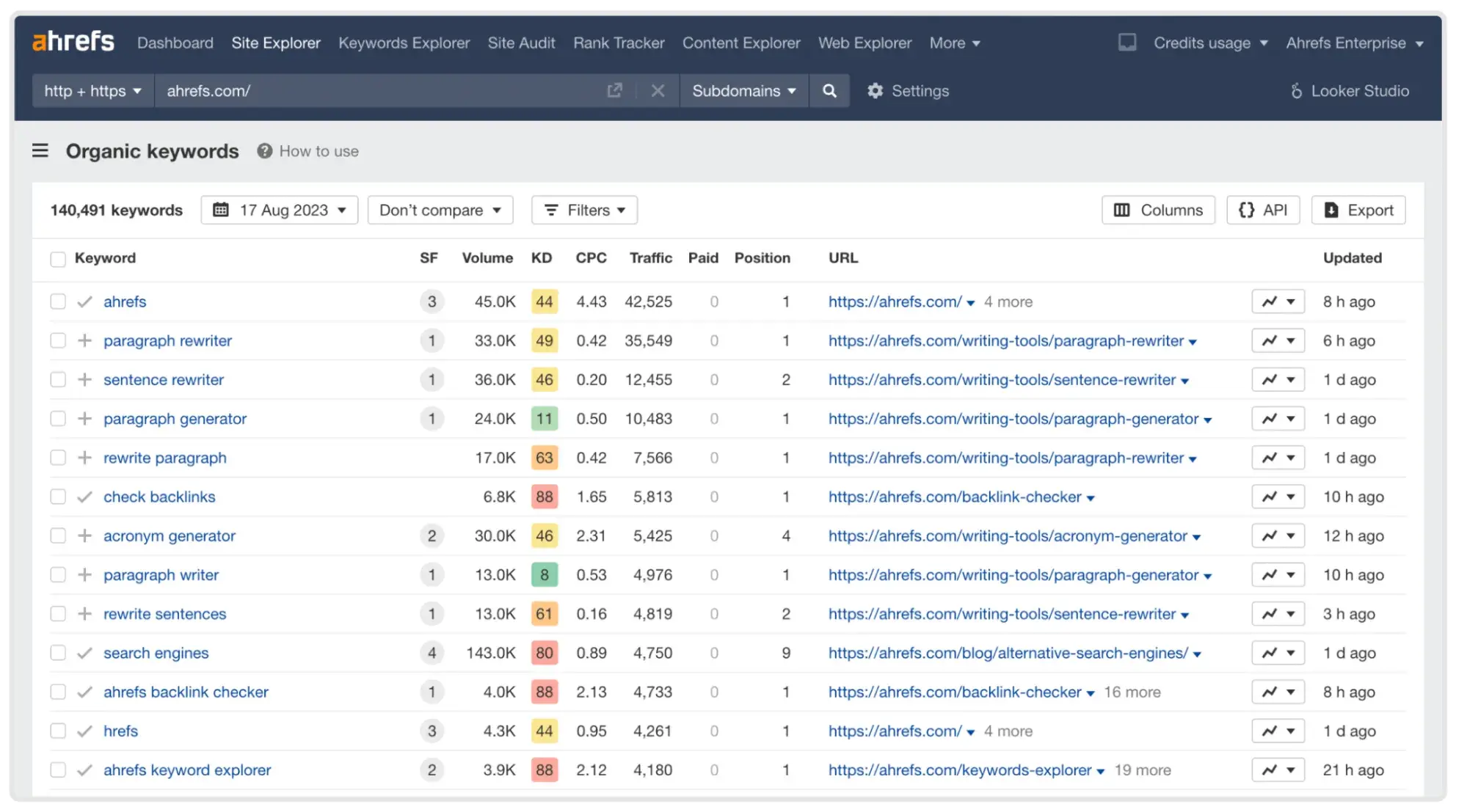
Ahrefs makes it simple to track your SEO site performance. It also offers powerful tools for keyword research, competitor analysis, and backlink tracking.
You can export specific reports or track URLs, SEO performance, or groups of keywords with this useful audit tool.
3. SEMrush
Price: Free trial, then pricing starts from $139.95/month.
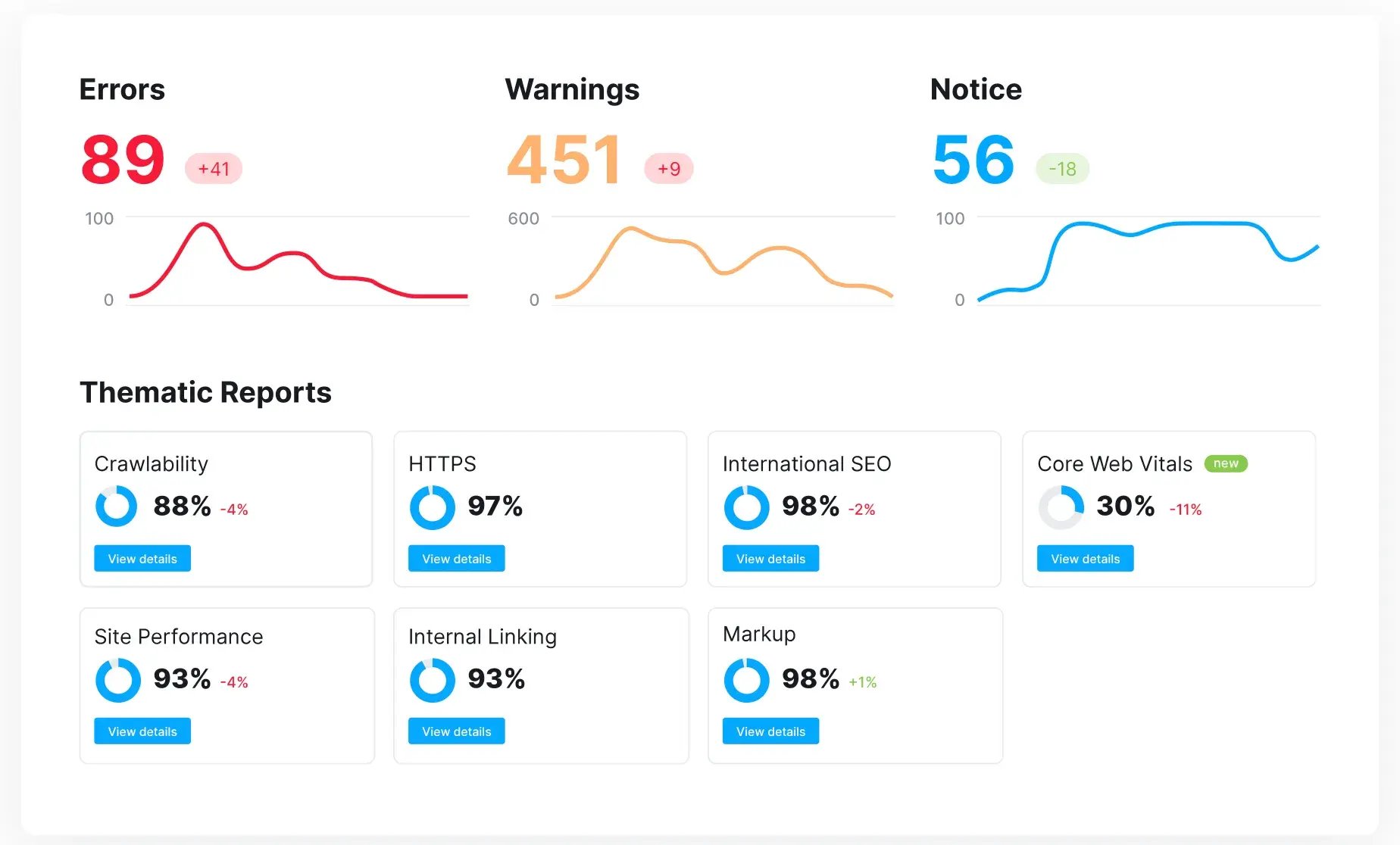
In a few steps, users of SEMrush can receive a robust site audit. By putting in the desired domain, you'll get a customized report that shows you where you can improve your site.
SEMrush’s features also include keyword research, content gaps, rank tracking, backlink analysis, and social media analytics.
4. Google Search Console
Price: Free
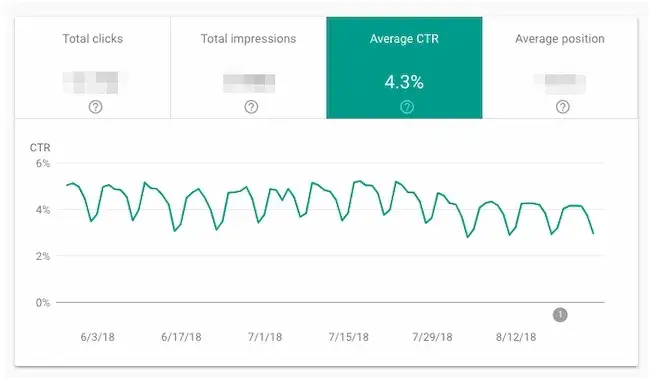
This tool makes it easy to track and analyze your website and search data. You can manually confirm that each page of your site is indexed and track URLs for useful data. The mobile usability issues features are also helpful during a content audit. You can also connect this tool to Google Analytics for more SEO insights.
Pro tip: Learn more about how to use Google Search Console with this useful post.
5. Google Analytics
Price: Free, with paid premium options.
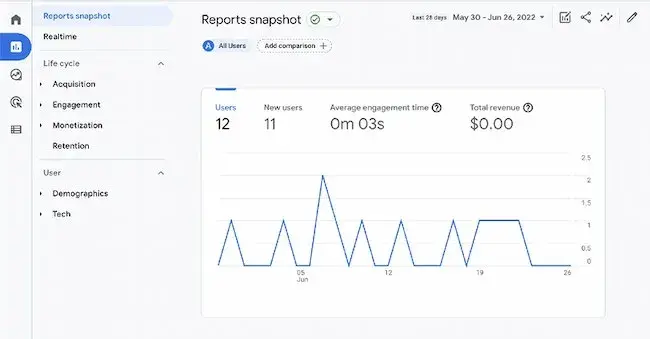
Google Analytics doesn't give you a traditional audit, but it provides good information to help formulate your audit. It lets you know who is visiting your website and from where. It also gives a rundown on the behaviors of your visitors.
Google sunsetted Universal Analytics in 2023. The new version, called Google Analytics 4 (GA4), uses data to identify (and even help predict) user behavior and give you a clearer picture of your buyer journey.
Pro tip: Another free Google tool, PageSpeed Insights, is a great way to track page speed on mobile and desktop devices.
6. WooRank
Price: Pricing for this tool starts at $19.99/month, and they offer Lite, Pro, Premium, and Enterprise plans.
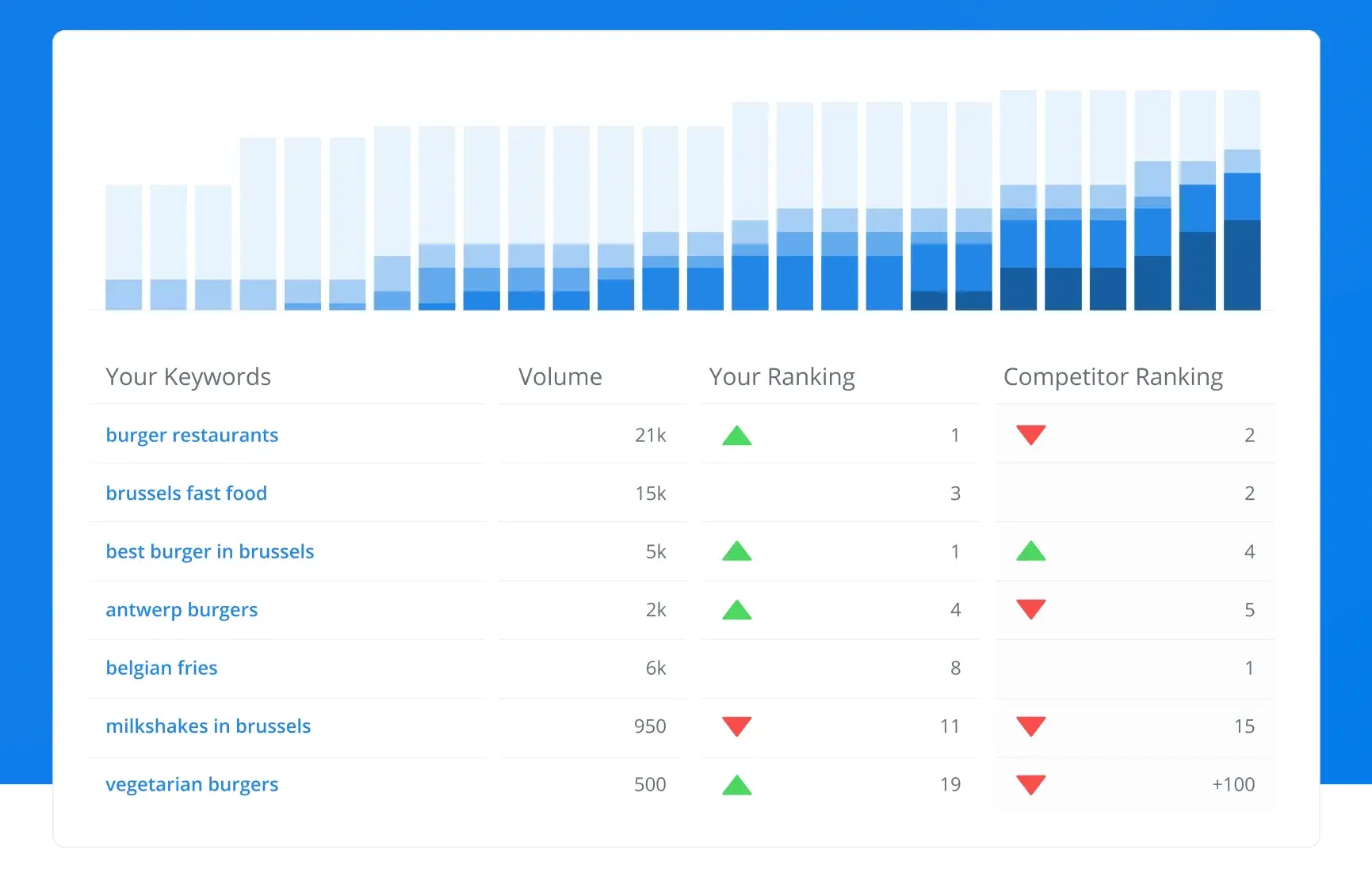
WooRank offers multiple features for SEO and content auditing that can help you analyze your site and come up with action items for the future. This includes site crawl, keyword tracking, website scoring, and competitive analysis.
Content Organization Tools
7. Google Sheets
Price: Free
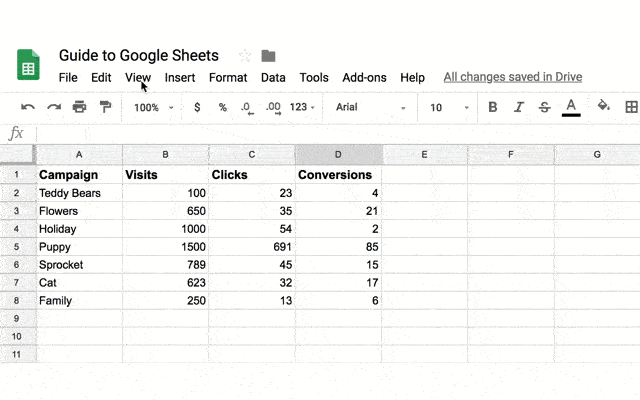
If you're not used to spreadsheets, this useful online tool makes it easy to organize your content audit. This tool can help you:
- Tie together different data points from your content audit
- Let team members collaborate and comment on data
- Offers formulas and other tools to update critical metrics
If you're not sure how to make the most of this tool, this guide to Google Sheets can help you get started.
Pro tip: Looking for more useful tools? This list of content marketing tools can help you organize and improve your content.
Another excellent resource to check out is HubSpot’s content marketing planning kit that includes eight templates such as customer segmentation, content mapping, content marketing calendar, and SEO planning, among others.
How to Do a Content Audit That Makes an Impact
Working on this piece taught me the importance of goal setting and systematic planning when it comes to carrying out a content audit. And I hope that this post has equipped you with the knowledge needed to perform one.
I’ve gone through how to conduct content audits, tools to speed up the process, and a template to guide you. You're fully prepared to use these audits in your organization for better content strategy and results.
Give it a try, and happy auditing!
Content Marketing


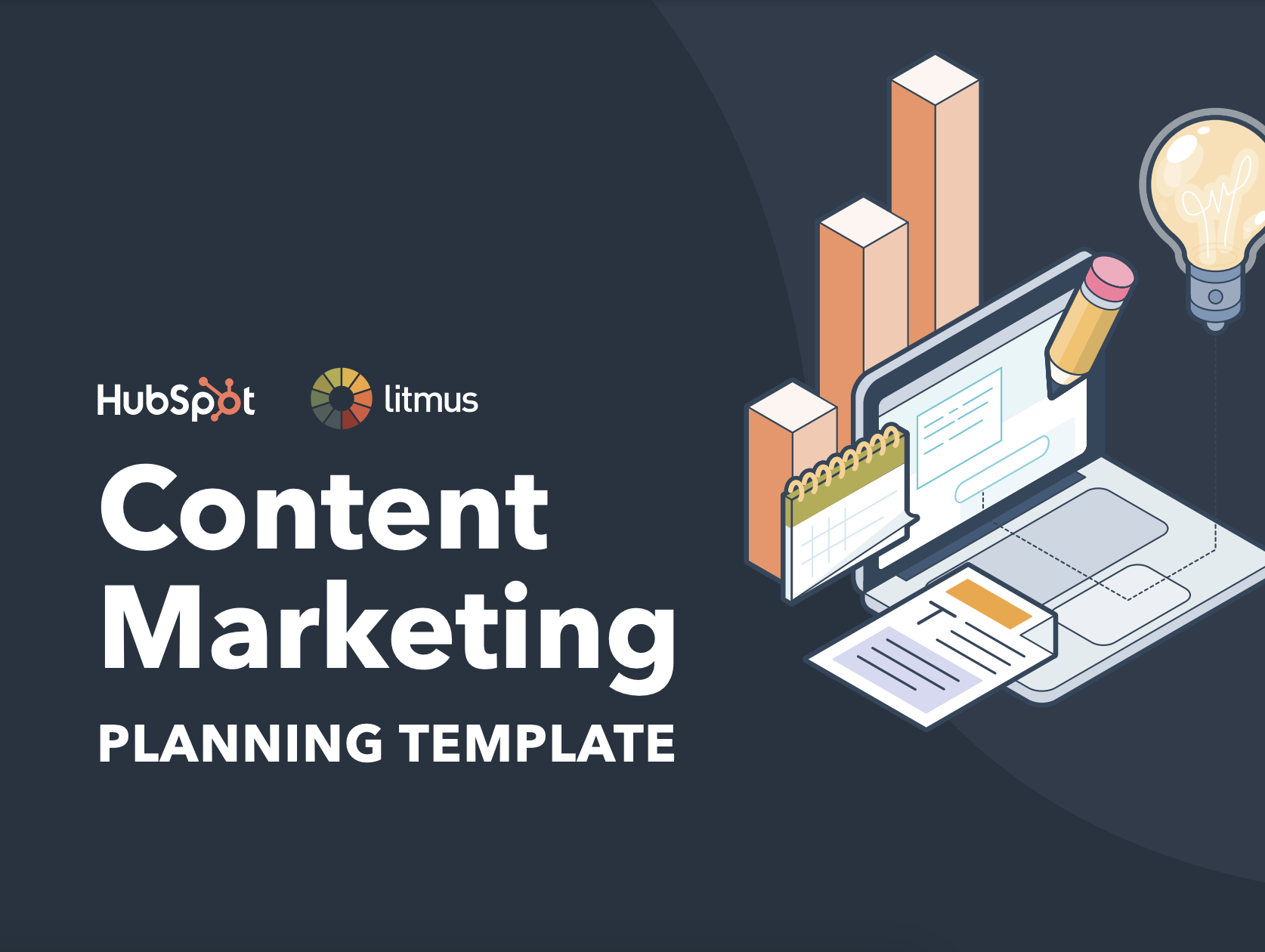
-1.webp)
![How to create a content style guide [+ free guide & examples]](https://53.fs1.hubspotusercontent-na1.net/hubfs/53/image1-May-07-2024-07-15-58-1152-PM.webp)



